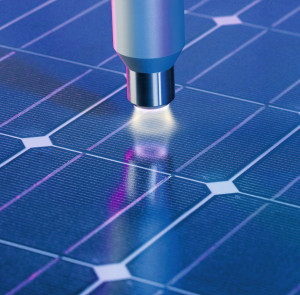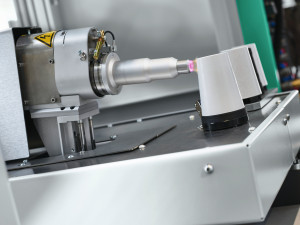Pioneering developments and visionary impulses in the field of plastics processing were the focus of the trade fair program of Plasmatreat GmbH from Steinhagen at the Düsseldorf plastics trade fair in October 2022. With its open-air plasma technology operating at atmospheric pressure, the company presented a safe, efficient and environmentally friendly alternative to conventional surface treatments for plastics.
More sustainable and better bonding, coating or printing
 Fig. 1: There are various areas of application for plasma technology in the solar industry (Photo: Plasmatreat)Visitors to the Plasmatreat stand learned how plasma works as an efficient, environmentally friendly alternative in industrial applications: During treatment with open-air plasma, oxygen- and nitrogen-containing groupings are introduced into the mostly non-polar plastics to increase the surface energy. In this way, non-reactive materials can be activated and optimally prepared for further industrial treatment. Activation increases the wettability of the surface and therefore also the adhesion capacity. This improves the adhesive strength of adhesives and coatings as well as the printability of the material. For materials for which activation is not sufficient, another process is available in the form of PlasmaPlus technology. This nanocoating specifically creates functionalized surfaces that can be both superhydrophobic and superhydrophilic. This results in further increased adhesion, for example. With plasma applications, the plastics processing industry as a whole benefits from an extended choice of materials, as this allows cost-intensive engineering plastics to be replaced with cheaper standard plastics, recycled materials to be processed reliably and even originally incompatible plastics to be joined together. All plasma processes are solvent-free, thus improving the environmental balance, can be used selectively and can be easily integrated into existing production lines. Companies using plasma technology (Fig. 1) can significantly reduce theirCO2 footprint and treat surfaces VOC-free.
Fig. 1: There are various areas of application for plasma technology in the solar industry (Photo: Plasmatreat)Visitors to the Plasmatreat stand learned how plasma works as an efficient, environmentally friendly alternative in industrial applications: During treatment with open-air plasma, oxygen- and nitrogen-containing groupings are introduced into the mostly non-polar plastics to increase the surface energy. In this way, non-reactive materials can be activated and optimally prepared for further industrial treatment. Activation increases the wettability of the surface and therefore also the adhesion capacity. This improves the adhesive strength of adhesives and coatings as well as the printability of the material. For materials for which activation is not sufficient, another process is available in the form of PlasmaPlus technology. This nanocoating specifically creates functionalized surfaces that can be both superhydrophobic and superhydrophilic. This results in further increased adhesion, for example. With plasma applications, the plastics processing industry as a whole benefits from an extended choice of materials, as this allows cost-intensive engineering plastics to be replaced with cheaper standard plastics, recycled materials to be processed reliably and even originally incompatible plastics to be joined together. All plasma processes are solvent-free, thus improving the environmental balance, can be used selectively and can be easily integrated into existing production lines. Companies using plasma technology (Fig. 1) can significantly reduce theirCO2 footprint and treat surfaces VOC-free.
Solar-powered racing car and recycled crinkle cup
One highlight of Plasmatreat's trade fair appearance was the presentation of pioneering application examples. Topics covered included the production of renewable energies and environmentally friendly mobility. The specialist in atmospheric plasma technology has many years of experience in solar technology, among other things. As part of the "Punch One" project, Belgian students developed a solar vehicle powered exclusively by solar energy to demonstrate the benefits of green energy. Thanks to plasma treatment, it has been possible to achieve optimum adhesion between the outer shell of the vehicle, the suspension and the structural ribs, while reducing material consumption and weight to a minimum. Plasmatreat was involved in the first asymmetrical vehicle, whose aerodynamic resistance was reduced by 30% compared to the symmetrical car, with an open-air plasma treatment for bonding the stiffening ribs, which are intended to prevent bending moments and twisting of the basic structure, as well as the fixed connection to the body. This would make it possible to replace time-consuming and labor-intensive previous methods that resulted in additional weight. Plasmatreat continues to support new ideas and approaches in this direction and often works together with universities and colleges.
 Fig. 2: Plasmatreat demonstrates how open-air plasma pre-treatment can be used to achieve durable, high-quality printing on drinking cups made from recycled PP (Photo: Arburg)In addition to the use of new materials, open-air plasma can also be used to improve the further processing of recycled plastics. This was demonstrated using an application example in collaboration with injection molding machine manufacturer Arburg: Plasmatreat demonstrated at K how open-air plasma pre-treatment can be used to achieve durable, high-quality printing on drinking cups made from recycled PP (Fig. 2). The cups are printed using UV digital printing with solvent-free inks without the use of additional adhesion promoters and impress with a brilliant print result.
Fig. 2: Plasmatreat demonstrates how open-air plasma pre-treatment can be used to achieve durable, high-quality printing on drinking cups made from recycled PP (Photo: Arburg)In addition to the use of new materials, open-air plasma can also be used to improve the further processing of recycled plastics. This was demonstrated using an application example in collaboration with injection molding machine manufacturer Arburg: Plasmatreat demonstrated at K how open-air plasma pre-treatment can be used to achieve durable, high-quality printing on drinking cups made from recycled PP (Fig. 2). The cups are printed using UV digital printing with solvent-free inks without the use of additional adhesion promoters and impress with a brilliant print result.
Science Corner: Have materials brought along tested on site
In the vast majority of cases, plasma treatment extends the range of further processing options. But can your own unresolved material problem also be solved with plasma applications? Is it possible, for example, to get even more out of certain plastics in terms of bonding, coating or printing? At K, visitors were able to get a quick initial indication of the material they were using by bringing a sample to the Plasmatreat stand. The experts in atmospheric plasma technology tested these in the Science Corner and immediately provided an initial assessment.


